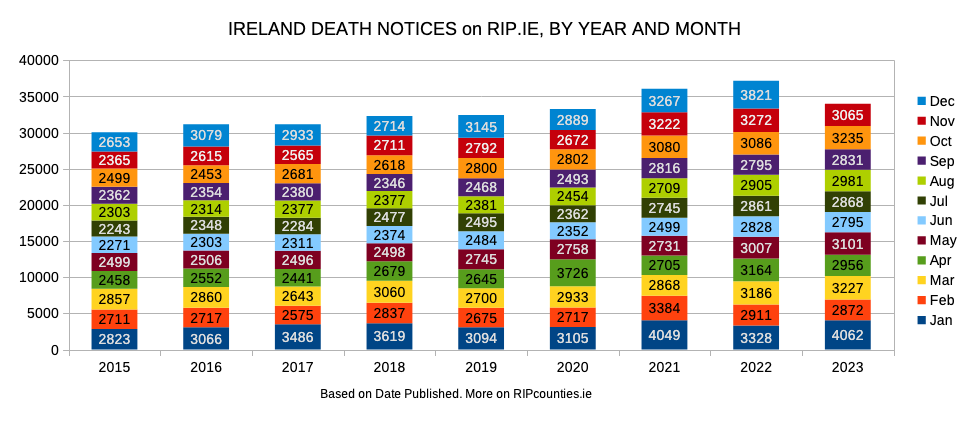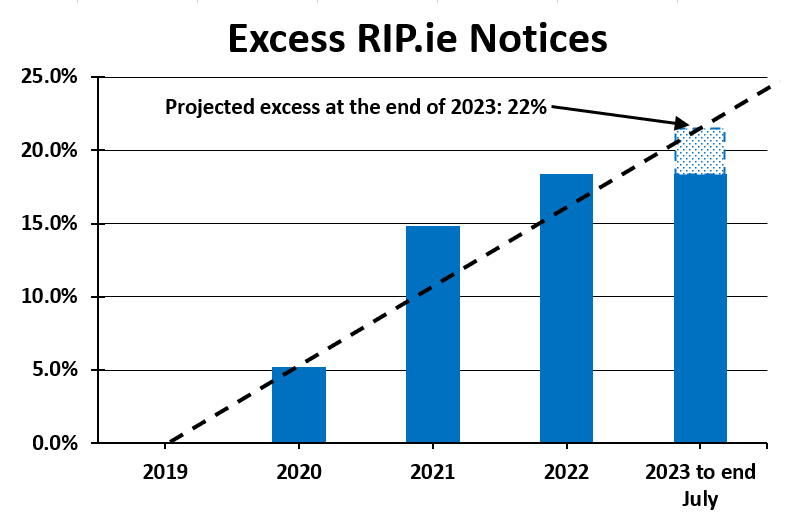
February 2020 (the previous leap year) saw 2717 death notices. An average of 94 per day.
This February we see 3161. An average of 109 per day. That’s a 16% increase.
How’s your county doing?
Scroll our Counties page and see for yourself.

February 2020 (the previous leap year) saw 2717 death notices. An average of 94 per day.
This February we see 3161. An average of 109 per day. That’s a 16% increase.
Scroll our Counties page and see for yourself.

Up 430 on December 2023 death notices. More details on The National Picture and individual county pages.

While still well above what historical patterns might lead us to expect, the number of December 2023 death notices1Based on date of publication, not date of death. Also, as we each use different methods of gathering, cleaning and processing our data there will be slight differences between our figures and those of Ireland Excess Deaths and Irish Quislings. But we’re each seeing the same trends. suggest an easing of the upward trend.



What’s happening in your county? Find out here.
We had only managed 22 counties before changes to RIP.ie hampered us.
Now, thanks to great help from a few sources, we have been able to start again. This time with improved accuracy AND the previously missing four counties of Cork, Dublin, Kerry and Louth,1In the interest of transparency you can still view an archive of our original 22-county work here.
All 26 counties are listed alphabetically on our Counties page.

This week we were contacted by someone far more adept at spreadsheets. So redoing our figures just got easier, we now have a fairly good overview of the national picture and can soon update our county pages.
Meanwhile here are our numbers for the country.

Keep in mind that, as we each use different methods of gathering, cleaning and processing our data, there will be slight differences1To date the biggest difference we’ve noted is about 1% and for 2016 only. All other years we tend to be within 0.01% and 0.5% of each other. between our figures and those of Ireland Excess Deaths and Irish Quislings.
But we’re each seeing the same trends.
Thankfully, while still well above what historical patterns suggest we should expect, November death notices on RIP.ie suggest an easing of the upward trend. We can see this in the average death notices per month and week.



Kilkenny accountant Patrick E. Walsh continues his sleuthing.
His most recent exploration of the October 4th Central Statistics Office (CSO) publication suggests ‘Official Ireland’ could be angling to ‘disappear’ the growing proportion of our people that are dying.
“The CSO has indirectly confirmed excess mortality rates in a recent publication and come up with a way to ‘hide’ current and future excess death rates…
It was issued quietly and ties in with the lies and half truths put forward by ‘Official Ireland’ in response to questions put to a TD about the extraordinary rate of excess mortality in Ireland…
I realise this is long and at times complicated but please stick with it as I believe this is vitally important in understanding how ‘Official Ireland’ is going to ‘disappear’ excess mortality in the coming years while not actually directly acknowledging what is going on at the moment…”
Patrick E. Walsh
Worth reading in full.
He also discussed what he found (and gave us a shout out – thanks Patrick!) with Gerry O’Neill a few days ago:

Speaking in Dáil Éireann on July 11th, An Taoiseach Leo Varadkar dismissed excess deaths as an issue of concern – despite previously acknowledging in February there had been an increase (see videos here).
So it is good to see this new group using official General Register Office (GRO) and RIP.ie data to determine, in near real-time, the amount of excess deaths occurring in Ireland.
We hope you will spread the word about them – and print and share their leaflet. It is designed for home printing in either A4 single-sided or A5 double-sided format.
We are a collective, united by our shared concern for the well-being of our communities and by our interest in statistics. Free from political or corporate affiliations, our sole purpose is the pursuit of truth, especially concerning public health data.
From the start of 2021, many of us began to notice more deaths than usual within our personal circles. Yet, without up-to-date data from official channels like the General Register Office and Central Statistics Office, we could not be sure. So, to bridge this gap, we developed a method to analyze excess deaths using RIP.ie, a website which catalogues over 99% of Irish deaths.
To provide the Irish public with accurate information about excess deaths, hoping to encourage informed debate, discussion and conversation. We aim to empower people to seek transparency and comprehensive investigations into rising death rates.
• Distribute the leaflet: attached are PDF leaflets designed for both colour and black-and-white printing. They can be printed as A4 single-sided or A5 double-sided. Share them in your community, at your workplace and/or with family and friends. You can also use the PDFs to order copies from your printing shop.
• Be Considerate: many have faced trauma during these times. If distributing or talking about the leaflet, do so with care and gentleness. Allow people time to read, research and reach their own conclusions.
• Support The Cause: As well as distributing the leaflet, you can support by volunteering or contributing to printing and delivery costs. Contact us through www.IrelandExcessDeaths.com
Our goal is for each person in Ireland to be informed, engaged, and empowered to make a difference. We believe we can achieve this together.
More on: IrelandExcessDeaths.com | Twitter | Telegram | TikTok
Recent changes to RIP.ie made our layman’s method unworkable. So, we have paused our project for the moment and are reflecting.
One of the key things emerging from these deliberations is that our numbers could be, and need to be, more accurate.
As pointed out here, our one-county-at-a-time approach meant there would be some duplicates across two or more counties. We assumed this wouldn’t be a big deal as our intention was to encourage others to look at trends within a chosen county.
But as people did so and the county graphs accumulated, it became more apparent that comparing trends in one county to those in another might also be desirable. Additionally, duplicates across counties would mean the final national total would be exaggerated – thus undermining this project’s credibility and usefulness.
We realise now a better approach would have been to start at national level, remove the duplicates there and then count the notices in each county.
If we can manage to do that we’ll update our website. One thing is certain though, it’s going to take us some time.
The new website format/design has been applied to RIP.ie

So, as anticipated our basic “copy & paste” method no longer works as before. Also, clicking old URLs saved in a spreadsheet (e.g. when checking if two entries are duplicates) gives us “404 page not found” errors.
The intention was that our method could be replicated by others with similarly basic spreadsheet skills – thereby allowing other ‘ordinary folk’ to check things for themselves and not have to take the expert or official word for things.
But perhaps…
In the meantime we will finish off the counties we have the data for and hope this is not the end of our project.
But if it is, we can only hope our work to date has helped the growing grass-roots efforts to highlight the change in death patterns of recent years and the media and official silence on the matter.
A silence which stands in stark contrast to their incessant clamouring about the numbers (they claimed) were dying early in the pandemic.